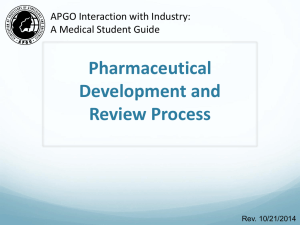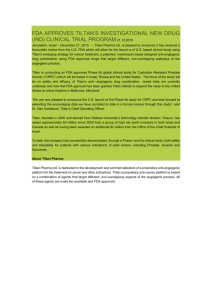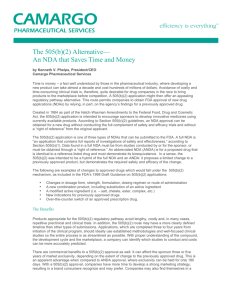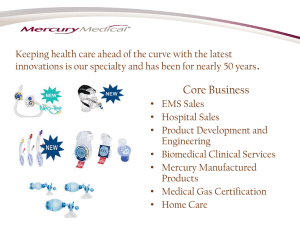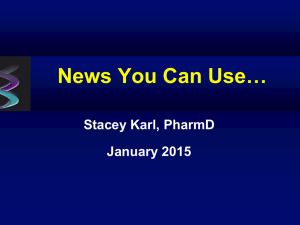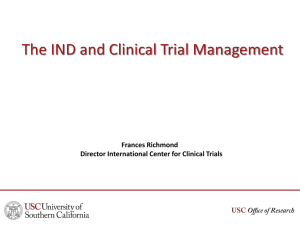Drug Development and Review Process
advertisement
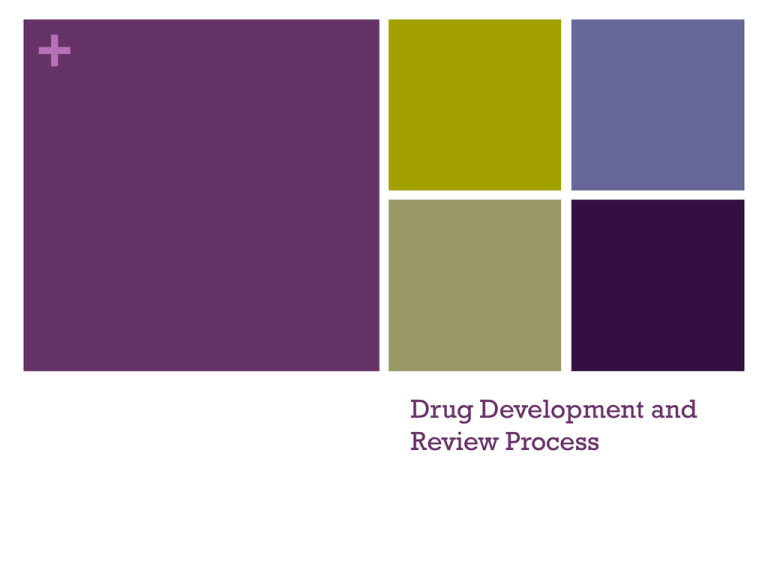
+ Drug Development and Review Process + Objectives Learn the processes involved in drug discovery and development Define the phases involved in FDA drug approval Explain the role of the Food and Drug Administration (FDA) in the drug development and review process in the United States + Research and Development Process (R&D) Development of new drugs is a complex and costly process It takes an average of 12 years and about $350 million to get a new drug from the laboratory to the pharmacy shelf R&D involves discovery (preclinical studies) and development (clinical studies) Only one in 1000 compounds which begin laboratory testing will make it to human testing + Role of FDA The Food and Drug Administration (FDA) is required to review and approve all new drugs in the United States The FDA reviews and evaluates new drugs based on the evidence presented from the clinical research studies performed by the drug sponsor-typically a pharmaceutical company + Summary of Drug Development and Evaluation + Preclinical Studies Synthesis and purification of the new drug Pharmacology of the new drug: Pharmacokinetics: absorption, distribution, metabolism, excretion, half-life Pharmacodynamics: mechanism of action and estimates of therapeutic effects Toxicology including carcinogenicity, mutagenicity, and teratogenicity Efficacy studies on animals + IND Investigational New Drug (IND): Application for permission to administer a new drug to humans Outlines the proposal to use the new drug for human testing in clinical trials Studies in humans can only begin after IND is reviewed and approved by the FDA and an institutional review board (IRB) + Clinical Studies Phase 1: Efficacy studies on healthy volunteers Phase 2: Clinical studies on a limited scale Phase 3: Comparative studies on large number of patients New Drug Application (NDA): Regulatory review Phase 4: Continued comparative studies. Registration and market introduction + Phase 1 Typically involves 20-80 healthy volunteers (no women of childbearing potential) Emphasis is on drug safety Goal is to identify major side effects, metabolism and routes of excretion Lasts about 1 year About 70% of drugs will pass this phase + Phase 2 Typically involves 100-300 individuals who have the target disease Emphasis is on effectiveness Patients receiving the drug are compared to similar patients receiving a placebo or another drug Lasts about 2 years About 33% of drugs will pass this phase + Phase 3 Typically involves 1000-3000 patients Emphasis is on safety and effectiveness Investigates through well-controlled studies different populations and different dosages as well as uses new drug in combination with other drugs Lasts about 3 years 25-30% of drugs will pass this phase + NDA Pre-NDA period: FDA and drug sponsors meet Submission of NDA: Formal step asking the FDA to consider approving a drug for marketing FDA has 60 days to decide whether it will file it for approval consideration If filed, a review team is assigned to evaluate the new drug + FDA Role The review team evaluates the research on the safety of the drug and its effectiveness The FDA reviews the information to go on the drug label It inspects the facilities where the drug will be manufactured The application will be classified as “approvable” or “not approvable” + FDA Role If approvable, the FDA requests additional information from the sponsor The NDA is again reviewed Following drug approval, sponsors of the drug will be required to continually assess the safety of the drug + Phase 4 Post-market surveillance of the drug to continually assess the safety of the drug May include incidence and severity of rare adverse reactions, cost-effectiveness analyses, comparative trials, and quality of life studies + Resources http://www.fda.gov/Drugs/DevelopmentApprovalProcess/d efault.htm






